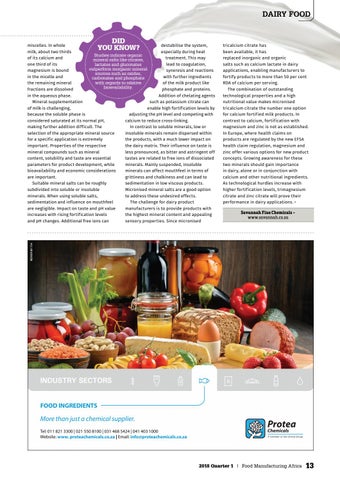DAIRY FOOD DID YOU KNOW?
miscelles. In whole destabilise the system, milk, about two thirds especially during heat Studies indicate organic of its calcium and treatment. This may mineral salts like citrates, one third of its lead to coagulation, lactates and gluconates outperform inorganic mineral magnesium is bound syneresis and reactions sources such as oxides, in the micelle and with further ingredients carbonates and phosphate with regards to relative the remaining mineral of the milk product like bioavailability. fractions are dissolved phosphate and proteins. in the aqueous phase. Addition of chelating agents Mineral supplementation such as potassium citrate can of milk is challenging, enable high fortification levels by because the soluble phase is adjusting the pH level and competing with considered saturated at its normal pH, calcium to reduce cross-linking. making further addition difficult. The In contrast to soluble minerals, low or selection of the appropriate mineral source insoluble minerals remain dispersed within for a specific application is extremely the products, with a much lower impact on important. Properties of the respective the dairy matrix. Their influence on taste is mineral compounds such as mineral less pronounced, as bitter and astringent off content, solubility and taste are essential tastes are related to free ions of dissociated parameters for product development, while minerals. Mainly suspended, insoluble bioavailability and economic considerations minerals can affect mouthfeel in terms of are important. grittiness and chalkiness and can lead to Suitable mineral salts can be roughly sedimentation in low viscous products. subdivided into soluble or insoluble Micronised mineral salts are a good option minerals. When using soluble salts, to address these undesired effects. sedimentation and influence on mouthfeel The challenge for dairy product are negligible. Impact on taste and pH value manufacturers is to provide products with increases with rising fortification levels the highest mineral content and appealing and pH changes. Additional free ions can sensory properties. Since micronised
tricalcium citrate has been available, it has replaced inorganic and organic salts such as calcium lactate in dairy applications, enabling manufacturers to fortify products to more than 50 per cent RDA of calcium per serving. The combination of outstanding technological properties and a high nutritional value makes micronised tricalcium citrate the number one option for calcium fortified milk products. In contrast to calcium, fortification with magnesium and zinc is not as established. In Europe, where health claims on products are regulated by the new EFSA health claim regulation, magnesium and zinc offer various options for new product concepts. Growing awareness for these two minerals should gain importance in dairy, alone or in conjunction with calcium and other nutritional ingredients. As technological hurdles increase with higher fortification levels, trimagnesium citrate and zinc citrate will prove their performance in dairy applications. •
Savannah Fine Chemicals – www.savannah.co.za
2018 Quarter 1 | Food Manufacturing Africa
13
